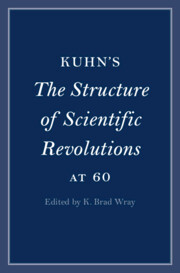Book contents
- Kuhn’s The Structure of Scientific Revolutions at 60
- Cambridge Philosophical Anniversaries
- Kuhn’s The Structure of Scientific Revolutions at 60
- Copyright page
- Dedication
- Contents
- Figures
- Tables
- Contributors
- Acknowledgments
- Abbreviations
- Introduction
- Part I Writing Structure
- 1 “… I probably would never have written Structure”
- 2 The Influence of Science Funding Policy on Kuhn’s Structure of Scientific Revolutions
- Part II Normal Science and Science Education
- Part III Incommensurability, Progress, and Revolutions
- Part IV Kuhn’s Impact on the Philosophy, Sociology, and History of Science
- Bibliography
- Index
1 - “… I probably would never have written Structure”
from Part I - Writing Structure
Published online by Cambridge University Press: 05 January 2024
- Kuhn’s The Structure of Scientific Revolutions at 60
- Cambridge Philosophical Anniversaries
- Kuhn’s The Structure of Scientific Revolutions at 60
- Copyright page
- Dedication
- Contents
- Figures
- Tables
- Contributors
- Acknowledgments
- Abbreviations
- Introduction
- Part I Writing Structure
- 1 “… I probably would never have written Structure”
- 2 The Influence of Science Funding Policy on Kuhn’s Structure of Scientific Revolutions
- Part II Normal Science and Science Education
- Part III Incommensurability, Progress, and Revolutions
- Part IV Kuhn’s Impact on the Philosophy, Sociology, and History of Science
- Bibliography
- Index
Summary
Toward the end of his life, Thomas Kuhn came to know the then new historical literature that substantially revised our understanding of Rudolf Carnap’s ideas. He was so taken with the emerging parallels between his own work and Carnap’s that he said “if I had known about it, if I had been into the literature at that level, I probably would never have written Structure.” Kuhn’s statement here is truly remarkable. There are, of course, both similarities and differences between Carnap and Kuhn. The similarities suggest that their two views are open to some of the same significant challenges and criticisms. But the differences suggest how each can help the other to meet the criticisms posed.
Keywords
- Type
- Chapter
- Information
- Kuhn's The Structure of Scientific Revolutions at 60 , pp. 21 - 36Publisher: Cambridge University PressPrint publication year: 2024

